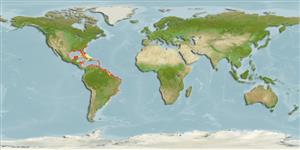Elasmobranchii (tubarões e raias) (sharks and rays) >
Torpediniformes (Electric rays) >
Narcinidae (Numbfishes)
Etymology: Narcine: Greek, narke = numbness (Ref. 45335).
Environment: milieu / climate zone / depth range / distribution range
Ecologia
marinhas associadas(os) a recifes; intervalo de profundidade 1 - 43 m (Ref. 13608). Subtropical; 37°N - 39°S, 98°W - 34°W
Western Atlantic: Espirito Santo, Brazil to northern Argentina (Carvalho, pers. comm.). North Carolina, USA to Florida, northern Gulf of Mexico, central Lesser Antilles and Yucatan (Ref. 26938).
Comprimento de primeira maturação / Tamanho / Peso / Idade
Maturity: Lm 28.8 range ? - ? cm
Max length : 54.0 cm WD macho/indeterminado; (Ref. 26340); common length : 35.0 cm WD macho/indeterminado; (Ref. 5217); peso máx. publicado: 650.00 g (Ref. 6902)
Descrição suscinta
Chaves de identificação | Morfologia | Morfometria
A pale sand-colored ray, often with ellipses of dark spots on dorsal side of rounded disk (Ref. 26938). Grayish to reddish brown, many rounded blotches outlined with blackish spots. Dark bands across tail up to dorsal fin. Snout darkened (Ref. 7251).
Inhabits coastal waters, on sand or mud bottoms (Ref. 26340). Common along sandy shorelines, sometimes near coral reefs (Ref. 12951). Aggregates in shallow waters ca. 10-20 m deep during summer and autumn months, dispersing to deeper waters during winter (Ref. 114953). Buries itself with only eyes protruding (Ref. 12951). Nocturnal, moves to shallow bays at night to feed; prefers worms, but may take juvenile snake eels, anemones, and, small crustaceans (Ref. 12951). Produces broods of 4 to 15 young (Ref. 26938). Reaches ca. 45 cm TL. Both sexes mature by 27 cm TL; birth size at ca. 11 cm TL (Ref. 114953). Can discharge between 14 and 37 volts. Contact with the skin can produce a severe electric shock. In addition to the main electric organ, this species possesses a bilateral accessory electric organ (Ref. 10011) speculated to have a possible role in social communication (Ref. 10489). Reported to taste good, but not fished commercially. Traded as an aquarium fish at Ceará, Brazil (Ref. 49392).
Ciclo de vida ou comportamento de acasalamento
Maturities | Reprodução | Spawnings | Egg(s) | Fecundities | Larvas
Ovoviviparous. Sex ratio of embryos is about one to one, however, small mothers may have predominantly female embryos and that for a given mother, embryos tend to be of one sex (Ref. 46979). Maximum number of embryos per female may reach 15. The young are capable of giving off electric charges even before they are released from the womb (Ref. 46978).
Robins, C.R. and G.C. Ray, 1986. A field guide to Atlantic coast fishes of North America. Houghton Mifflin Company, Boston, U.S.A. 354 p. (Ref. 7251)
Status na Lista Vermelha da UICN (Ref. 130435)
Uso pelos humanos
Pescarias: pesca de subsistência; Aquário: Espécies comerciais
Ferramentas
Relatórios especiais
Baixar XML
Fontes da internet
Estimates based on models
Preferred temperature (Ref.
123201): 22.9 - 28, mean 25.6 °C (based on 442 cells).
Índice de diversidade filogenética (Ref.
82804): PD
50 = 0.5000 [Uniqueness, from 0.5 = low to 2.0 = high].
Bayesian length-weight: a=0.01122 (0.00605 - 0.02082), b=2.90 (2.73 - 3.07), in cm total length, based on LWR estimates for this species & (Sub)family-body (Ref.
93245).
Nível Trófico (Ref.
69278): 3.2 ±0.4 se; based on diet studies.
Resiliência (Ref.
120179): Baixo, tempo mínimo de duplicação da população 4,5 - 14 anos (Assuming fecundity<100).
Fishing Vulnerability (Ref.
59153): Low to moderate vulnerability (34 of 100).
Nutrients (Ref.
124155): Calcium = 6.47 [0.67, 106.25] mg/100g; Iron = 0.472 [0.039, 5.319] mg/100g; Protein = 16.6 [12.4, 21.0] %; Omega3 = 0.145 [0.049, 0.421] g/100g; Selenium = 14.3 [2.3, 70.5] μg/100g; VitaminA = 22.2 [1.8, 283.1] μg/100g; Zinc = 0.82 [0.06, 9.22] mg/100g (wet weight);
